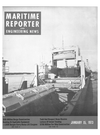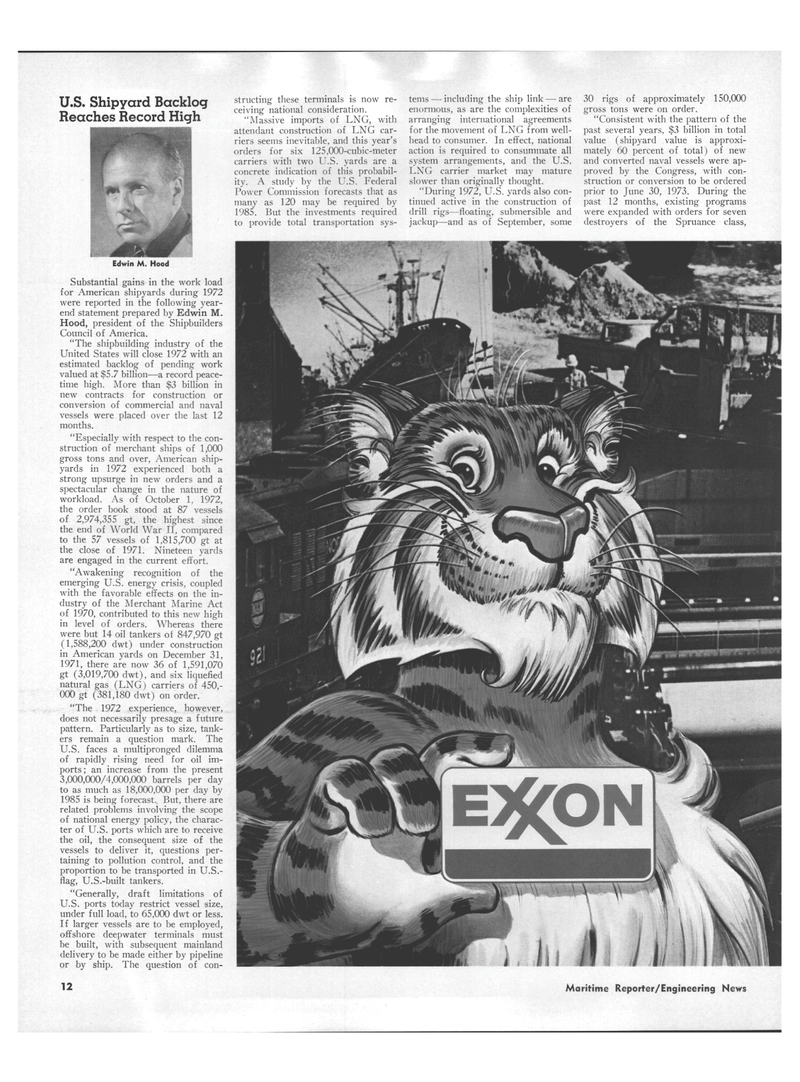
Page 10: of Maritime Reporter Magazine (January 15, 1973)
Read this page in Pdf, Flash or Html5 edition of January 15, 1973 Maritime Reporter Magazine
U.S. Shipyard Backlog
Reaches Record High
Edwin M. Hood
Substantial gains in the work load for American shipyards during 1972 were reported in the following year- end statement prepared by Edwin M.
Hood, president of the Shipbuilders
Council of America. "The shipbuilding industry of the
United States will close 1972 with an estimated backlog of pending work valued at $5.7 billion—a record peace- time high. More than $3 billion in new contracts for construction or conversion of commercial and naval vessels were placed over the last 12 months. "Especially with respect to the con- struction of merchant ships of 1,000 gross tons and over, American ship- yards in 1972 experienced both a strong upsurge in new orders and a spectacular change in the nature of workload. As of October 1, 1972, the order book stood at 87 vessels of 2,974,355 gt, the highest since the end of World War II, compared to the 57 vessels of 1,815,700 gt at the close of 1971. Nineteen yards are engaged in the current effort. "Awakening recognition of the emerging U.S. energy crisis, coupled with the favorable effects on the in- dustry of the Merchant Marine Act of 1970, contributed to this new high in level of orders. Whereas there were but 14 oil tankers of 847,970 gt (1,588,200 dwt) under construction in American yards on December 31, 1971, there are now 36 of 1,591,070 gt (3,019,700 dwt), and six liquefied natural gas (LNG) carriers of 450,- 000 gt (381,180 dwt) on order. "The 1972 experience, however, does not necessarily presage a future pattern. Particularly as to size, tank- ers remain a question mark. The
U.S. faces a multipronged dilemma of rapidly rising need for oil im- ports ; an increase from the present 3,000,000/4,000,000 barrels per day to as much as 18,000,000 per day by 1985 is being forecast.. But, there are related problems involving the scope of national energy policy, the charac- ter of U.S. ports which are to receive the oil, the consequent size of the vessels to deliver it, questions per- taining to pollution control, and the proportion to be transported in U.S.- flag, U.S.-built tankers. "Generally, draft limitations of
U.S. ports today restrict vessel size, under full load, to 65,000 dwt or less.
If larger vessels are to be employed, offshore deepwater terminals must be built, with subsequent mainland delivery to be made either by pipeline or by ship. The question of con- structing these terminals is now re- ceiving national consideration. "Massive imports of LNG, with attendant construction of LNG car- riers seems inevitable, and this year's orders for six 125,000-cubic-meter carriers with two U.S. yards are a concrete indication of this probabil- ity. A study by the U.S. Federal
Power Commission forecasts that as many as 120 may be required by 1985. But the investments required to provide total transportation sys- tems —- including the ship link — are enormous, as are the complexities of arranging international agreements for the movement of LNG from well- head to consumer. In effect, national action is required to consummate all system arrangements, and the U.S.
LNG carrier market may mature slower than originally thought. "During 1972, U.S. yards also con- tinued active in the construction of drill rigs—floating, submersible and jackup—and as of September, some 30 rigs of approximately 150,000 gross tons were on order. "Consistent with the pattern of the past several years, $3 billion in total value (shipyard value is approxi- mately 60 percent of total) of new and converted naval vessels were ap- proved by the Congress, with con- struction or conversion to be ordered prior to June 30, 1973. During the past 12 months, existing programs were expanded with orders for seven destroyers of the Spruance class, 12 Maritime Reporter/Engineering News

 9
9

 11
11
